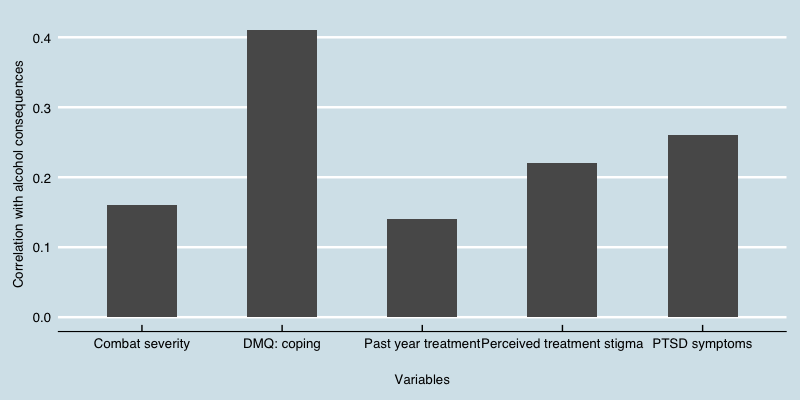The DRAM, Vol. 13(6) – Leave no one behind: Understanding problem drinking among veterans
Reports by journalists as well as research studies have taught us that American veterans returning home after their service often find it difficult to transition back to civilian life. Some estimates suggest that for every four returning veterans you meet, one of them is likely to report having symptoms that are consistent with Posttraumatic Stress Disorder (PTSD). Researchers have also found that, for veterans, combat experience and PTSD are linked to higher rates of alcohol use and problems. In this week’s DRAM, we review a study by Stephen M. Miller and colleagues that investigates the pathways that lead from combat exposure and PTSD to alcohol problems in veterans.
What was the research question?
What factors predict adverse alcohol consequences among young adult veterans?
What did the researchers do?
The study relied on data collected as part of a larger longitudinal study that employed Facebook to reach veterans. Veterans of the Air Force, Army, Marine Corps or Navy between ages 18 and 34 (N=312) participated in the study. The authors gathered data on combat severity, PTSD symptom severity, frequency of drinking for coping reasons, perceived stigma of behavioral health treatment seeking, and adverse consequences participants attributed to their drinking in the past 30 days. They then used a path model to analyze the relationships among these variables.
What did they find?
The authors found that drinking to cope and perceived stigma of seeking treatment mediated the relationship between PTSD symptoms and adverse alcohol consequences. In other words, veterans with greater PTSD symptom severity were more likely to drink as a way to cope (for example, to forget about their problems), as well as to view receiving treatment as something negative. Further, among veterans with greater PTSD symptom severity, both perceived stigma of seeking treatment and drinking to cope predicted higher negative alcohol-related consequences. (see Figure).
Why do these findings matter?
The findings suggest two specific avenues for intervention that will help veterans experiencing PTSD to recover and avoid further adverse consequences as civilians. Firstly, programs targeted towards veterans that raise awareness about the nature of PTSD and appropriate resources to deal with it will help them avoid turning to alcohol in order “to forget.” Secondly, educational programs that combat the stigma associated with behavioral health treatment seeking will benefit veterans. While we know that such stigma exists in the general population, studies have shown that the phenomenon is especially acute in the military population. Programs designed to discredit the notion that seeking treatment for a disorder or disease makes one “weak” will help veterans.
Every study has limitations. What are the limitations in this study?
In the study, after providing their initial responses, participants were followed up after one month. Other studies that follow-up on participants after a longer time horizon will help provide further confidence that the relationships found in the study don’t vanish after a short duration. Also, as the study relied on a self-reported measure of PTSD, we cannot be sure how well it conforms to a clinically administered measure – future studies that rely on the latter criteria will be instructive.

Figure. Bivariate correlation estimates with alcohol consequences. Note: DMQ = Drinking Motives Questionnaire; PTSD = Posttraumatic Stress Disorder;
All estimates shown in the graph above are statistically significant. Adapted from Miller et.al. (2017). Click image to enlarge.
For more information:
Are you a veteran and are having problems with alcohol or drug use? Please visit the Veterans Alcohol and Drug Dependence Rehabilitation Program.
If you are concerned about yours or a loved one’s substance use, visit our resource page for brief screens to assess substance use and self-help tools.
— Pradeep Singh
What do you think? Please use the comment link below to provide feedback on this article.